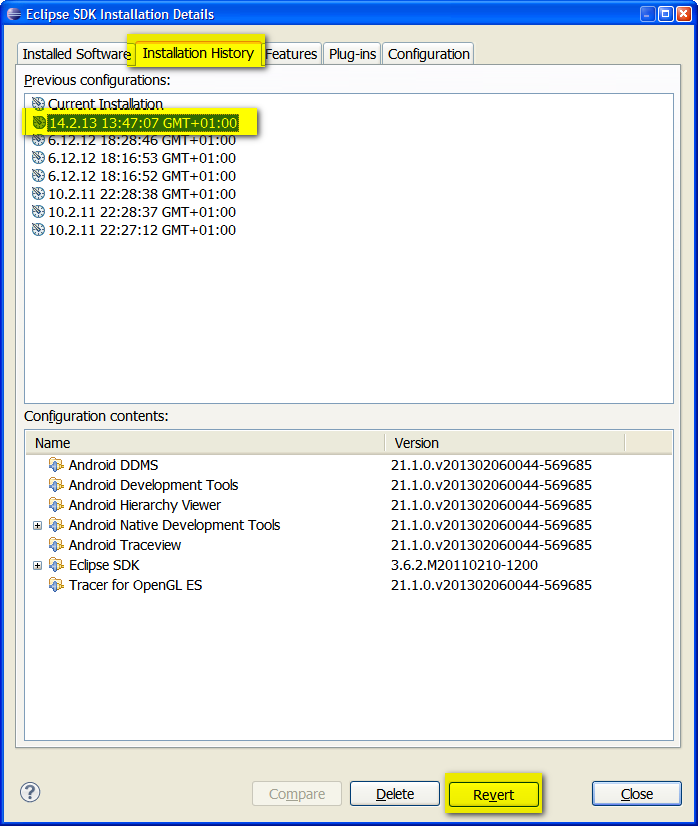Difference between “@+id/” and “@id/” in Android
Difference between "@+id/” and "@id/” in Android
android:id="@+id/xxx" unique identifier of view
@id/ a reference to the unique identifier
android:id="@+id/xxx" unique identifier of view
@id/ a reference to the unique identifier
<TextView
android:id="@+id/first_element_id"
.........
/>
<TextView
android:id="@+id/second_element_id"
android:layout_below="@id/first_element_id"
..........
/>
396LW NO topic_id
AD
Další témata ....(Topics)
Problem:
You have two class with similar names HeadLinesFragment and HeadMyLinesFragment with OnHeadlineSelectedListener.
Check if call correct class in MainActivity.
For example if use HeadMyLinesFragment change implement to HeadMyLinesFragment too!
You have two class with similar names HeadLinesFragment and HeadMyLinesFragment with OnHeadlineSelectedListener.
Check if call correct class in MainActivity.
For example if use HeadMyLinesFragment change implement to HeadMyLinesFragment too!
public class MainActivity extends FragmentActivity
implements HeadLinesFragment.OnHeadlineSelectedListener {
// wrong implements you need correct class name
//implements HeadMyLinesFragment.OnHeadlineSelectedListener
//............
HeadMyLinesFragment firstFragment = new HeadMyLinesFragment(); // because in code using HeadMyLinesFragment
If you have trouble with compilation of new project after you make a update of android development tools you can go back to old version of the tools.


-
- Open Help > About Eclipse... use the menu > About...
- Click the "Installation Details" button.
- Select the "Installation History" tab.
- Select one of the previous configurations.
- Click the "Revert" button at the bottom.


public class MainActivity extends Activity implements OnClickListener {
@Override
public void onCreate(Bundle savedInstanceState) {
super.onCreate(savedInstanceState);
setContentView(R.layout.main);
LinearLayout layout = (LinearLayout) findViewById(R.id.layout);
RadioGroup radioGroup = new RadioGroup(this);
LinearLayout.LayoutParams p = new LinearLayout.LayoutParams(
LinearLayout.LayoutParams.FILL_PARENT,
LinearLayout.LayoutParams.WRAP_CONTENT
);
layout.addView(radioGroup, p);
RadioButton radioButtonView = new RadioButton(this);
radioButtonView.setText("RadioButton");
radioButtonView.setOnClickListener(this);
radioGroup.addView(radioButtonView, p);
RadioButton radioButtonView2 = new RadioButton(this);
radioButtonView2.setText("RadioButton2");
radioButtonView2.setOnClickListener(mThisButtonListener);
radioGroup.addView(radioButtonView2, p);
}
public void onClick(View view) {
try {
String s = ((RadioButton) view).getText().toString();
Toast.makeText(MainActivity.this, "This is: " + s,
Toast.LENGTH_LONG).show();
}
catch (Exception e1) {
e1.printStackTrace();
}
}
private OnClickListener mThisButtonListener = new OnClickListener() {
public void onClick(View v) {
String s = ((RadioButton) v).getText().toString();
Toast.makeText(MainActivity.this, "Hello from 2!" + s,
Toast.LENGTH_LONG).show();
}
};
}
public class Main extends Activity {
private TextView mTextView;
private Activity mAct;
private Intent mIntent;
protected void onCreate(Bundle savedInstanceState) {
super.onCreate(savedInstanceState);
setContentView(R.layout.main_layout);
mTextView = findViewById(R.id.mTextView);
mAct = getActivity();
mIntent = getIntent();
}
}
to:
public class Main extends Fragment{
private TextView mTextView;
private FragmentActivity mFrgAct;
private Intent mIntent;
private LinearLayout mLinearLayout;
public View onCreateView(LayoutInflater inflater, ViewGroup container,
Bundle savedInstanceState) {
View root = inflater.inflate(R.layout.fragment_main, null);
return root;
}
public void onViewCreated(View view, Bundle savedInstanceState) {
// you can add listener of elements here
/*Button mButton = (Button) view.findViewById(R.id.button);
mButton.setOnClickListener(this); */
mTextView = view.findViewById(R.id.mTextView);
mLinearLayout = (LinearLayout)view;
}
public void onActivityCreated(Bundle savedInstanceState) {
super.onActivityCreated(savedInstanceState);
mFrgAct = getActivity();
mIntent = mFrgAct.getIntent(); // Intent intent = new Intent(getActivity().getIntent());
}
}
| Brand | Samsung |
| Model (codename) | i9250 Galaxy Nexus |
| Cena, včetně DPH | 9000 |
| Veikost Displaye v palcích | 4.65 |
| Display-resolution | 1280x720 |
| Dotek-typ | kapacitní |
| CPU typ | |
| CPU MHz | 1200 |
| CPU core | 2 |
| L2 cache | |
| RAM | 1 GB |
| ROM | 16 - 32 GB |
| GPU | TI OMAP 4460 1,2 GHz dual-core |
| NenaMark2 Benchmark | |
| GPU-GLBenchmark | |
| Baterie mAh | 1750 |
| Foto MPx | 5 |
| Autofocus | yes |
| Video | 480p - 30 frames/s |
| Official Android ICS | Android 4.0 Ice Cream Sandwich |
| CyanogenMod support | |
| Dotek-prstů-max | |
| Display-ppi | |
| Display-retina | |
| Network | GSM&EDGE: 850 / 900 / 1.800 / 1.900 |
| Connectivity | |
| Pozn. |
samsung-i9250-galaxy-nexus image

Editace: 2015-12-01 11:31:06
Počet článků v kategorii: 396
Url:difference-between-id-and-id-in-android



